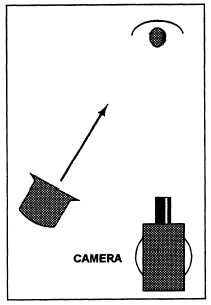types of productions where the talent remains immobile
at the time of sound pickup. Several microphones
located about the set can accommodate moving talents,
but the talents must position themselves near the
microphone before speaking.
Most hanging microphones do not produce good
audio. If placed too close to walls or overheads, an echo
or distorted audio is likely to occur.
Hidden
The sound quality of hidden microphones is
mediocre at best, and frequently the object they are
hidden in or behind distorts the sound. For this reason,
you should use hidden microphones sparingly.
One type of hidden microphone is called a contact
microphone, because it is in direct contact with the
object producing the desired sound effect. An example
is a microphone attached to a quick-acting watertight
door to pickup the sound of the handwheel and dogs.
TELEVISION LIGHTING
LEARNING OBJECTIVE: Identify the
principles of television lighting.
Earlier in this chapter, we noted that the television
camera changes various levels of light reflected from
objects in the scene into electrical impulses of varying
strength. Therefore, the primary objective in any
television lighting setup is to ensure sufficient
illumination for the correct operation of the television
camera. However, at the same time, television lighting
must support or even establish the atmosphere of the set
or scene.
Television lighting essentially follows the same
principles as photographic lighting (Chapter 11). For the
sake of clarity, however, we will take a brief look at
lighting as it applies to this medium.
COLOR TEMPERATURE
Before we cover the principles of television
lighting, we must address color temperature briefly.
Color temperature is the amount of certain colors
that make up a particular white light measured in
degrees Kelvin (K). Since the television camera changes
images into electronic impulses, the wavelengths of
light that vibrate at various frequencies and makeup the
different hues or colors will have an effect on the output
of the camera.
The simplest way to think of color temperature,
without getting into complicated formulas, is to say that
light of a lower color temperature appears more toward
the orange end of the scale, while light of a higher color
temperature appears more toward the blue end of the
scale.
Studio lighting is standardized at 3200°K Daylight
sources are balanced in the range of 5000°K to 7000°K
You do not have to know what a degree Kelvin is
specifically, as long as you accept it as a unit of measure
and know how color temperature effects the color
television picture.
STUDIO LIGHTING
In this section, we cover the following factors that
contribute to proper studio lighting:
l Three-point lighting (key light, fill light and
backlight)
l Use of the f/stop
l Proper lighting intensity
. Proper lighting placement
l Skin tones
Key Light
The key light (fig. 14-27) serves as the main light
source. It provides sufficient light to operate the camera
and acts as the reference point for all other lighting.
Place the key light in front of the subject and off to the
side at about a 45-degree angle, then elevate it 30 to 35
Figure 14-27.—Key light.
14-25


